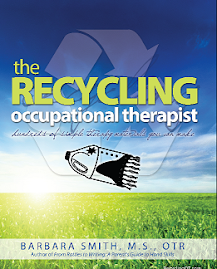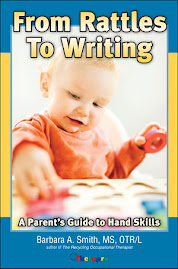I work with very young hippotherapy clients. My youngest was 11 months old and she cried so much , I told the parents to come back later when older. She did return 6 months later and did very well.
Not every facility offers hippotherapy services with such young children but I have found that the 18 months to 3 year old early intervention clients are my favorite. They often start out crying, perhaps for a few weeks and then realize how much they love the experience. There was only one child who cried intensely for about 3 weeks and the mom and I agreed that he should stop.

So what to do with the crying hippotherapy client? Lets take a look at the reasons for crying.....
- the child is not used to and does not want to separate from the caregiver
- the horse is big and scary
- all new experiences are scary
- the child finds the sensory experience (i.e. movement) threatening and scary
- the environment is over-stimulating
Strategies:
1. Its not always possible to work in the ideal environment, but if possible decrease the number of people and horses, sound and action taking place around the sensory sensitive, young child. I have learned to lower my naturally loud voice as needed.
2. I explain to parents that most young children cry during the first few weeks. It may be beneficial to at first have the parent side walk or walk within view of the child. Sometimes the child does better when the parent is out of view. Some of my parents want to be the side walker all the time (and that's OK) and others enjoy the break. The parents and situations vary, but its good to explore the options that decrease crying during the first 2-3 weeks.
3. Spend time introducing the horse while holding the child, patting, brushing and talking to the horse. Sometimes I spend time playing with the child before even going near the horse so that the child is more comfortable with me before separating from the caregiver.
4. Once the child is on the horse, get moving, stay moving, sing and talk about what you are both looking at. I hang pictures of animals on the arena walls and if we are outside there is of course, lots to talk about. I also find the song "If you're happy and you know it pat the pony, clap your hands, blow a kiss....." familiar and calming.
5. I encourage the child to bond with me the therapist, by telling the volunteers to minimally interact and after 1-2 weeks I encourage the parent in the waiting area to not interact. I turn the child to face sideways so that we can look into each others face, as soon as the child is able to tolerate this because we can bond even better in this position.
6. If I do something that the child really hates (i.e. kneeling, bearing weight on hands) and he or she cries, I do it briefly and count to 5 or 10 or sing the ABC song so that the child knows it will be ending soon. I then switch to a preferred activity or no demands riding.
7. If the child is super upset and you feel uncomfortable keeping him on the horse, play with the child in the waiting area with the parent nearby or perhaps while the child sits on the parent's lap. Try not to send them home early- that gives the wrong message.
8. Sometimes kids are just feeling sick and the session needs to end early. This is especially apparent when working with a child who usually loves hippotherapy.
9. Discuss with the parent how they feel about the situation. Do they have suggestions? Some parents bring in a favorite toy from home.
10. .......and most importantly, involve the child in choice making with words, pointing or pictures so that they feel in control and have fun!
 We spent the beautiful spring day outside and the kids were all in great happy moods. This little guy is facing sideways while we walk up a hill. I am encouraging him to put weight on his right hand. I gave him some joint compression input to the elbow when not holding the camera, too. He has very low muscle tone and avoids touching let alone grasping objects. We played the game called "you grasp the chick with both hands and don't let go even when I pull". He is starting to understand that he has to really use some muscle to play this game!
We spent the beautiful spring day outside and the kids were all in great happy moods. This little guy is facing sideways while we walk up a hill. I am encouraging him to put weight on his right hand. I gave him some joint compression input to the elbow when not holding the camera, too. He has very low muscle tone and avoids touching let alone grasping objects. We played the game called "you grasp the chick with both hands and don't let go even when I pull". He is starting to understand that he has to really use some muscle to play this game! 








